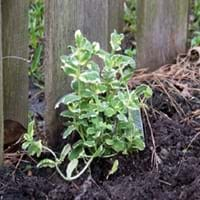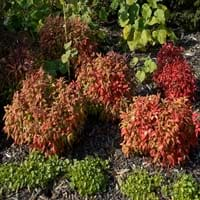Life Span
Perennial
Perennial
Type
Herbs
Broadleaf Evergreen
Origin
Southern Europe
China, Japan
Types
Not Available
Heavenly Bamboo, Nandina 'Colerno'
Dwarf Nandina 'Compacta'
Dwarf Nandina 'Filamentosa'
Heavenly Bamboo, Nandina 'Harbor Belle'
Heavenly Bamboo, Nandina 'Moon Bay'
Number of Varieties
Not Available
Habitat
Cultivated Beds, Dappled Shade, Shady Edge, Sunny Edge, Woodland Garden
low mountains, Mountain tops, Mountains, Valley
USDA Hardiness Zone
6-9
6-11
AHS Heat Zone
9-5
Not Available
Sunset Zone
4, 5, 6, 7, 8, 9, 10, 11, 12, 13, 14, 16, 17, 18, 19, 20, 21, 22, 23, 24
21,22
Habit
Spreading
Clump-Forming
Minimum Width
Not Available
Flower Color
White, Pink
Not Available
Flower Color Modifier
Bicolor
Bicolor
Fruit Color
Brown
Not Available
Leaf Color in Spring
White, Light Green
Green, Purple, Copper
Leaf Color in Summer
White, Light Green
Green, Purple
Leaf Color in Fall
White, Light Green
Green, Purple
Leaf Color in Winter
Light Green
Red, Green, Purple
Leaf Shape
Oval
Acuminate
Plant Season
Spring, Summer, Fall
Spring, Summer, Fall, Winter
Sunlight
Partial Sun, Partial shade
Full Sun, Partial Sun, Partial shade, Full Shade
Type of Soil
Clay, Loam, Sand
Loam, Sand
The pH of Soil
Acidic, Neutral
Acidic, Neutral, Alkaline
Soil Drainage
Poorly Drained
Well drained
Bloom Time
Summer
Not Available
Tolerances
Drought
Drought
Where to Plant?
Container, Ground, Pot
Ground
How to Plant?
By dividing rhizomes, tubers, Stem Cutting
Seedlings
Plant Maintenance
Medium
Medium
Watering Requirements
Average Water Needs, Do Not over Water, Requires regular watering
Do not water frequently, Needs less watering
In Summer
Lots of watering
Lots of watering
In Spring
Moderate
Moderate
In Winter
Average Water
Average Water
Soil pH
Acidic, Neutral
Acidic, Neutral, Alkaline
Soil Type
Clay, Loam, Sand
Loam, Sand
Soil Drainage Capacity
Poorly Drained
Well drained
Sun Exposure
Partial Sun, Partial shade
Full Sun, Partial Sun, Partial shade, Full Shade
Pruning
Prune in the growing season, Remove damaged leaves, Remove dead branches, Remove dead leaves
Remove damaged leaves, Remove dead branches, Remove dead leaves
Fertilizers
All-Purpose Liquid Fertilizer, Fertilize in early spring
All-Purpose Liquid Fertilizer
Pests and Diseases
Red blotch
Red blotch
Plant Tolerance
Drought
Drought
Flower Petal Number
Single
Not Available
Fragrant Bark/Stem
Yes
No
Foliage Texture
Medium
Fine
Foliage Sheen
Matte
Glossy
Attracts
Bees, Butterflies, pollinators
Mealybugs, Whiteflies
Allergy
Itchiness, Skin rash, Stomach pain, Swelling
Not Available
Aesthetic Uses
Bonsai, Showy Purposes
Bonsai, Borders
Beauty Benefits
Good for skin
Not Available
Environmental Uses
Air purification
Air purification
Medicinal Uses
Antiseptic, Digestive disorders, Fever, Headache
Antirheumatic, Antitussive, Astringent
Part of Plant Used
Fruits, Leaves
Fruits, Leaves
Other Uses
Added to salads, Used as essential oil, Used in making tea, Used to make herbal teas
Used for making informal hedge
Used As Indoor Plant
Yes
No
Used As Outdoor Plant
Yes
Yes
Garden Design
Bog Garden, Edible, Groundcover, Herb / Vegetable
Container, Edging, Foundation, Groundcover, Hedges, Mixed Border, Topiary, Bonsai, Espalier
Botanical Name
MENTHA suaveolens 'Variegata'
NANDINA domestica 'Nana Purpurea'
Common Name
Applemint, Variegated Applemint
heavenly bamboo
sacred bamboo
nandina
In Hindi
Applemint Tree
Dwarf Nandina
In German
Applemint Baum
Dwarf Nandina
In French
Applemint Arbre
Nandina Dwarf
In Spanish
Árbol Applemint
Nandina enana
In Greek
Applemint Δέντρο
Dwarf Nandina
In Portuguese
Árvore applemint
Nandina do anão
In Polish
Applemint Drzewo
Dwarf Nandina
In Latin
Applemint ligno
Dwarf Nandina
Phylum
Magnoliophyta
Tracheophyta
Class
Magnoliopsida
Magnoliopsida
Order
Lamiales
Ranunculales
Family
Lamiaceae
Berberidaceae
Clade
Angiosperms, Asterids, Eudicots
Angiosperms, Eudicots
Tribe
Mentheae
Not Available
Subfamily
Faboideae
Not Available
Number of Species
Not Available
Not Available
Season and Care of Applemint and Dwarf Nandina
Season and care of Applemint and Dwarf Nandina is important to know. While considering everything about Applemint and Dwarf Nandina Care, growing season is an essential factor. Applemint season is Spring, Summer and Fall and Dwarf Nandina season is Spring, Summer and Fall. The type of soil for Applemint is Clay, Loam, Sand and for Dwarf Nandina is Loam, Sand while the PH of soil for Applemint is Acidic, Neutral and for Dwarf Nandina is Acidic, Neutral, Alkaline.
Applemint and Dwarf Nandina Physical Information
Applemint and Dwarf Nandina physical information is very important for comparison. Applemint height is 980.00 cm and width Not Available whereas Dwarf Nandina height is 30.00 cm and width 60.00 cm. The color specification of Applemint and Dwarf Nandina are as follows:
Applemint flower color: White and Pink
Applemint leaf color: White and Light Green
Dwarf Nandina flower color: Not Available
- Dwarf Nandina leaf color: Green, Purple and Copper
Care of Applemint and Dwarf Nandina
Care of Applemint and Dwarf Nandina include pruning, fertilizers, watering etc. Applemint pruning is done Prune in the growing season, Remove damaged leaves, Remove dead branches and Remove dead leaves and Dwarf Nandina pruning is done Remove damaged leaves, Remove dead branches and Remove dead leaves. In summer Applemint needs Lots of watering and in winter, it needs Average Water. Whereas, in summer Dwarf Nandina needs Lots of watering and in winter, it needs Average Water.





